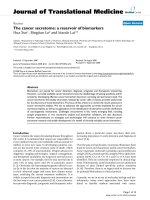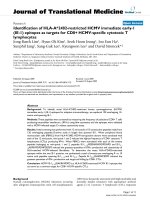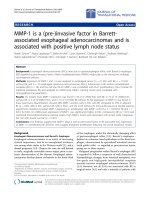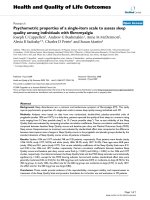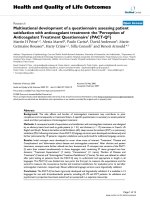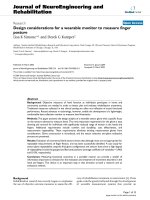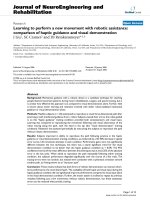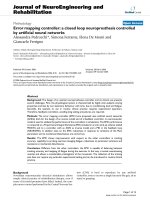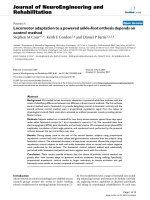báo cáo hóa học: " Methyl salicylate 2-O-b-D-lactoside, a novel salicylic acid analogue, acts as an antiinflammatory agent on microglia and astrocytes" docx
Bạn đang xem bản rút gọn của tài liệu. Xem và tải ngay bản đầy đủ của tài liệu tại đây (1.44 MB, 7 trang )
SHOR T REPO R T Open Access
Methyl salicylate 2-O-b-
D
-lactoside, a novel
salicylic acid analogue, acts as an anti-
inflammatory agent on microglia and astrocytes
Xi Lan, Rui Liu, Lan Sun, Tiantai Zhang
*
and Guanhua Du
*
Abstract
Background: Neuroinflammation has been known to play a critical role in the pathogenesis of Alzheimer’s disease
(AD). Activation of microglia and astrocytes is a characteristic of brain inflammation. Epidemiological studies have
shown that long-term use of non-steroidal anti-inflammatory drugs (NSAIDs) delays the onset of AD and
suppresses its progressio n. Methyl salicylate-2-O-b-
D
-lactoside (DL0309) is a new molecule chemically related to
salicylic acid. The present study aimed to evaluate the anti-inflammatory effects of DL0309.
Findings: Our studies show that DL0309 significantly inhibits lipopolysaccharide (LPS)-induced release of the pro-
inflammatory cytokines IL-6, IL-1b, and TNF-a; and the expression of the inflammation-related proteins iNOS, COX-
1, and COX-2 by microglia and astrocytes. At a concentration of 10 μM, DL0309 prominently inhibited LPS-induced
activation of NF-B in glial cells by blocking phosphorylation of IKK and p65, and by blocking IB degradation.
Conclusions: We demonstrate here for the first time that DL0309 exerts anti-inflammatory effects in glial cells by
suppressing different pro-inflammatory cytokines and iNOS/NO. Furthermore, it also regulates the NF-B signaling
pathway by blocking IKK and p65 activation and IB degradation. DL0309 also acts as a non-selective COX
inhibitor in glial cells. These studies suggest that DL0309 may be effective in the treatment of neuroinflammatory
disorders, including AD.
Findings
Alzheimer’s disease (AD) is a progressive neurodegenera-
tive disorder of the elderly characterized by global deficits
in cognition ranging from loss of memory to impaired
judgment. It has been hypothesized that early microglial
activation in AD delays disease progression by promoting
clearance of beta amyloid peptide (Ab) before formation
of senile plaques [1-3]. Microglia are a ntigen-presenting
cells that, upon activation, are capable of phagocytosis
and the production of variou s pro-inflammatory mol e-
cules such as nitric oxide (NO) and interleukin-1b (IL-
1b) [4]. These molecules are able to destroy pathogens,
but can also induce toxicity in neurons, which are com-
promised in AD. Furthermore, in aged human brain,
many microglia are dystrophic, showing morphological
features indicative of senescence such as fragmented
cytoplasmic processes [5]. Like microglia, chronically
activated astrocytes are believed to contribute to AD
through production of NO and of various pro-inflamma-
tory cytokines and chemokines. Apart from this, astro-
cytes become activated around plaques to take up Ab
and neuronal debris [6]. Not only that, activated astro-
cytes are also involved in plaque formation. Therefore,
agents that block the activation of microglia and astro-
cytes may be effective in the treatment of AD.
A recent study showed that the ad ministration of non-
steroidal anti-inflammatory drugs (NSAIDs) could delay
progression of AD, most likely because of their ability to
reduce microglial activation and cytokine release. The
presence of inflammatory processes in AD brains sug-
gests that anti-inflammatory agents like ibuprofen may
be beneficial in this disease [7]. NSAIDs have been well
studied, both in vitro and in vivo, and have been observed
to ameliorate inflammation related to Ab deposition in
AD. Several in vitro studies have shown that NSAIDs like
* Correspondence: ;
Beijing Key Laboratory of Drug Target and Screening Research, Institute of
Materia Medica, Chinese Academy of Medical Sciences & Peking Union
Medical College, No.1 Xiannongtan Street, Xicheng District, Beijing 100050, P.
R. China
Lan et al. Journal of Neuroinflammation 2011, 8:98
/>JOURNAL OF
NEUROINFLAMMATION
© 2011 Lan et al; licensee BioMed Central Ltd. This is an Open Access article distributed under the terms of the Creative Commons
Attribution License ( which permits unrestricted use, distri bution, and reproduction in
any medium, provided the or iginal work is properly cited.
aspirin might have anti-aggregation activity for Ab by
blocking the NF-B signaling pathway [8].
Methyl salicylate 2-O-b-
D
-lactoside (DL0309, Figure 1)
was isolated from Gaultheria yunnanensis (FRANCH) )
REHDER (G yunnanensis), which is a traditional Chinese
herbal medicine. G yunnanensis is widely used for the
treatment of rheumatoid arthritis, swelling, and pain [9].
Interestingly, DL0309 contains a chemical struc ture
similar to salicylic acid. Therefore, it is a natural salicylic
derivative, and belongs to the NSAIDs group. An anti-
inflammatory effect of Gaultheria has been demon-
strated in a croton oil-induced ear edema model in mice
[10]. Therefore, we investigated the capacity of DL0309
to suppress the production of pro-inflammatory cyto-
kines (IL-6, IL-1b,andTNF-a)andtheexpressionof
inflammation-related proteins (iNOS, COX-1, and
COX-2) in LPS-activated microglia and astrocytes, and
we explored the associat ion of these effects with activa-
tion of the NF-B pathway.
Primary rat glia cells were obtained through a modifica-
tion of McCarthy and deVellis’s p rotocol [11]. Primary
cells w ere cultured in DMEM/F12 medium containing 10%
FBS (Gibco), 1.4 M L-glutamine, 100 U/mL penicillin, and
0.1 m g/ml streptomycin; and were f ound to be of 95% p ur-
ity as determined by immunocytochemical staining with
ox42 and anti-glial fibrillary acidic protein (GFAP)
antibody.
To investigate the anti-inflammatory actions of DL0309,
microglia and astrocytes were incubated with DL0309 (0.1,
1.0 or 10 μM) in the presence or absence of LPS (0.5 μg/
ml) for 24 h. Pro-inflammatory cytokines (IL-6, IL-1b and
TNF-a) levels in the culture medium were measured by
ELISA. The production of NO-derivative nitrite was deter-
mined by the Griess reaction as described previously [12].
Western blot analy sis was carried out eval uating the
expression of iNOS, COX-1, COX-2, and NF-Bpathway-
relevant proteins such as IB-a, total/phosphorylated IKK
and NF-B-p65. Cells were plated overnight in 100 mm
dishes and pre-treated with DL0309 at concentrations of
0.1, 1.0 or 10 μM for 1 h. After exposing the cells to LPS
(0.5 μg/ml) for either 10 min or 45 min, cyt osolic protein
extracts we re prepared. COX-1 and COX-2 antibodies
were obtained from Abcam (Cambridge, UK). Other anti-
bodies were purchased from Cell Signaling Technology
(Beverly, MA, USA). Western blotting results were quanti-
fied using Quantity One software (Bio-Rad).
To determine th e direct inhibitory effects of DL0309
on COX-1 and COX-2 enzymatic activities, primary rat
glial cells were pre-incubated with LPS (0.5 μg/ml) for
24 h. Medium was then removed, and DL0309 (0.1, 1.0
or 10 μM) was added for 1 h. Cells were treated with
arachidonic acid, 30 μM, for another 20 min, and PGE
2
levels in the medium were then measured by ELISA
[13,14]. To investigate the effect of DL0309 on COX-1
enzymatic activity, cells were not treated with LPS in
order to express only the COX-1 isoform [15]. Thus,
measured PGE
2
levels represent COX-1 activity alone.
At least thr ee independent experiments were used for
data analysis. All data are presented as mean ± S.E.M.
Values were compared using a t-test (two groups) or
one-way ANOVA with post-hoc Student-Newman-Keuls
test (multiple comparisons).
Cell viability was determined by an MTT reduction assay
as described previously [12]. DL0309 did not show toxicity
to the cells at the concentrations examined (F igure 2A). As
shown by Griess ass ay, incubation with L PS alone mark-
edly increased (about 8-fold) NO production in the cells,
compared to that generated in control cells; DL0309 inhib-
ited LPS-induced NO release in microglia and astrocytes,
both in a dose-dependent manner (Figure 2B). F urther-
more, LPS increased the protein expression of iNOS both
in microglia (Figure 2C) and astrocytes (Figure 2D), while
pretreatment with DL0309 significantly decreased iNOS
expression at a concentration of 10 μM. These results
demo nstrate that DL0309 inhibits N O release, at least in
part by suppressing iNOS expression.
Neuroinflammation, represented by activated microglia
and astrocytes, is a prominent pathological feature that
contributestoneurodegenerationinAD.InADbrain,
activated microglia release a variety of neurotoxic com-
pounds and pro-inflammatory mediators, including IL-6,
IL-1b and TNF-a. As shown in Figure 3, IL-6 (A), IL-1b
(B) and TNF-a (C) levels were increased in culture med-
ium of LPS-stimulated glial cells. Our results show that
DL0309 significantly inhibits production of these proin-
flammatory cytokines, which may modulate AD.
Sustained up-regulation of pro-inflammatory media-
tors such as COX-1 and COX-2 in microglia and astro-
cytes contributes to the progressive character of AD.
LPS treatment significantly increased protein expression
of COX-1 and COX-2 in both microglia (Figure 4A)
Figure 1 Chemical structure of compoun d DL0309 (methyl
salicylate 2-O-b-D-lactoside).
Lan et al. Journal of Neuroinflammation 2011, 8:98
/>Page 2 of 7
and astrocytes (Figure 4B). Pre-treatment with DL0309
reduced this protein expression in a dose-dependent
manner in microglia. Additionally, DL0309 also directly
inhibited total COX (COX-1/2, Figure 4C) and COX-1
(Figure 4D) activity in a dose-dependent manner. These
results show that DL0309 acts a s a non-selective COX
inhibitor both in microglia and in astrocytes. These stu-
dies suggest that DL0309 may be effective in the treat-
ment of these disorders.
NF-B is known as an important regulator of various
genes invo lved in the production of many pro-inflamma-
tory cytokines and enzymes related to the inflammatory
process. Activation of NF-B is critical for the expression
of various cytokines, iNOS, COX-1 and COX-2 in micro-
glia in response to LPS [16]. Normally NF-B remains
inactivated by an inhibitory protein, IB. Once activated,
NF-B enters the nucleus to increase transcription of dif-
ferent inflammatory mediat ors. The phosphor ylation of
IB is regulated by IKK. Thus, we studied the effects of
DL0309 on NF-B activation. LPS strongly increased
phosphorylated IKK (Figure 5) and NF-B-p65 (Figure 6),
while simultaneously decreasing IB expression (Figure 7)
in primary microglia (A) and astrocytes (B). Our studies
demonstrate that DL0309 regulates the NF-B pathway by
suppressing LPS induction of pIKK and pNF-B-p65
activity in glial cells. We further demonstrated that
DL0309 blocks LPS-induced degradation of IB, which
blocks the nuclear translocation of NF-B.
In recent years, a number of mechanisms have been
proposed to account for the protective effects of aspirin
[17,18], ibuprofen [19] and other anti-inflammatory
agents in AD. Studies have shown various degrees (risk
reductions of up to 50%) of b enefit from the use of
NSAIDs on onset of disease and on dementia, with
increased duration of NSAIDs use having increased pro-
tective effect against AD [20]. The best characterized
action of these anti-inflammatory agents is to suppress
neuroinflammation, primarily through their ability to
inhibit COX, leading to reduced biosynthesis of pro-
inflammatory molecules in glial cells. Several studies
Figure 2 The inhibitor y effect of DL0309 on NO/iNOS induced by LPS in glial cells. Cells were pre-treated for 1 h with the indicated
concentrations (μM) of DL0309, and then stimulated by LPS (0.5 μg/ml) for 24 h. Cell viability was determined by MTT assay (A). The level of
nitrite in the culture medium was determined by the Griess reaction (B). iNOS protein levels in microglia (C) and astrocytes(D) were measured by
western blotting. Data represent the means ± S.E.M. of three independent experiments.
###
p < 0.001 vs. control; *p < 0.05, **p < 0.01 and ***p <
0.001 vs. LPS-treated cultures.
Lan et al. Journal of Neuroinflammation 2011, 8:98
/>Page 3 of 7
Figure 3 DL0309 inhibits LPS-induced cytokine release in glial cells. Cells were pre-treated for 1 h with the indicated concentrations of
DL0309, and then stimulated by LPS (0.5 μg/ml) for 24 h. IL-6 (A), IL-1b (B), and TNF-a (C) levels were measured in the culture medium by
ELISA. Data represent the means ± S.E.M. of three independent experiments.
#
p < 0.05,
##
p < 0.01 and
###
p < 0.001 vs. control; *p < 0.05, **p <
0.01 and ***p < 0.001 vs. LPS-treated cultures.
Lan et al. Journal of Neuroinflammation 2011, 8:98
/>Page 4 of 7
Figure 4 DL0309 inhibits COX-1/2 express ion and enzymatic activity in LPS- induced glial cells. Microglia (A) and astrocytes (B) were pre-
treated for 1 h with the indicated concentrations of DL0309, and continuously incubated with LPS (0.5 μg/ml) for 24 h. Levels of COX-1 and COX-1
were measured by western blotting. To measure total COX activity (COX-1/2) (C), cells were stimulated with LPS (0.5 μg/ml) for 24 h. After changing
the medium, cells were treated with various concentrations of DL0309 for 1 h. Cells were then treated with arachidonic acid, 30 μM, for another 20
min, and PGE
2
levels in the medium were then measured by ELISA. For the COX-1 activity assay (D), cells were pre-treated with various concentrations
of DL0309 for 1 h. After 30 μM of arachidonic acid was added for 20 min, PGE
2
levels in the cell medium were measured. Data represent the means ±
S.E.M. of three independent experiments.
#
p < 0.05,
##
p < 0.01 and
###
p < 0.001 vs. control; *p < 0.05 and **p < 0.01 vs. LPS-treated cultures.
Figure 5 DL0309 decreases phosphorylated IKK levels in LPS-activated glial cells. Microglia (A) and astrocytes (B) were pre-treated for 1 h
with the indicated concentrations of DL0309. LPS (0.5 μg/ml) was added and, 10 min later, proteins were isolated and the levels of
phosphorylated IKKa/b, IKKa and IKKb were measured by western blotting. Data represent the means ± S.E.M. of three independent
experiments.
#
p < 0.05 vs. control; *p < 0.05 vs. LPS-treated cultures.
Lan et al. Journal of Neuroinflammation 2011, 8:98
/>Page 5 of 7
have shown that the onset of AD may be apparently
suppressed or delay ed by mixed COX-1 and COX-2
inhibitors [21].
In summary, we demonstrate that DL0309 is capable
of acting as a non-selective inhibitor of COX-1 and
COX-2. DL0309 also regulates the NF-B s ignaling
pathway not only by blocking degradation of IB, but
also by restraining pIKK and pNF-B-p65 activity.
Therefore, this agent can suppress proteins that are
regulated by the NF-B pathway, including iNOS, NO
and the cytokines IL-1b, IL-6 and TNF-a. These studies
suggest that DL0309 may be an effective agent in the
treatment of neuroinflammatory disorders, including
AD.
Acknowledgements
This work was supported by National Scientific & Technological Major
Project for “ Significant New Drugs Creation” (No.2009ZX09102-034 ), the
International S&T Cooperati on Projects (No.2 009DF A32 010) and Nation al
Natural Science Foundation (No. 81073120) by China government. We
are grateful to Dr. Xin Wang (Manchester University, UK) and Prof.
Humphrey Rang (London College University, UK) for the revision of
manuscript.
Figure 6 DL0309 reduces phosphorylated NF-B-p65 levels in LPS-activated glial cells. Microglia (A) and astrocytes (B) were pre-treated for
1 h with the indicated concentrations of DL0309. LPS (0.5 μg/ml) was added and, 10 min later, proteins were isolated and the levels of
phosphorylated NF-B-p65 and total p65 were measured by western blotting. Data represent the means ± S.E.M. of three independent
experiments.
#
p < 0.05 vs. control; *p < 0.05 vs. LPS-treated cultures.
Figure 7 DL0309 blocks degradation of IB by LPS-activate d glial cells. Microglia (A) and astrocytes (B) were pre-treated for 1 h with the
indicated concentrations of DL0309. LPS (0.5 μg/ml) was added and, 45 min later, proteins were isolated and levels of IB-a were measured by
western blotting. Data represent the means ± S.E.M. of three independent experiments.
###
p < 0.001 vs. control; *p < 0.05, **p < 0.01 and ***p <
0.001 vs. LPS-treated cultures.
Lan et al. Journal of Neuroinflammation 2011, 8:98
/>Page 6 of 7
Authors’ contributions
TZ and GD directed the work, contributed to design the study, reviewed the
data and wrote the manuscript; XL performed cell culture, western blot
analysis, ELISA assay and NO measurements; RL and LS helped in performing
NO measurements. All authors read and approved the final manuscript.
Competing interests
The authors declare that they have no competing interests.
Received: 7 April 2011 Accepted: 11 August 2011
Published: 11 August 2011
References
1. Maragakis NJ, Rothstein JD: Mechanisms of Disease: astrocytes in
neurodegenerative disease. Nat Clin Pract Neurol 2006, 2:679-689.
2. Wyss-Coray T, Loike JD, Brionne TC, Lu E, Anankov R, Yan F, Silverstein SC,
Husemann J: Adult mouse astrocytes degrade amyloid-beta in vitro and
in situ. Nat Med 2003, 9:453-457.
3. Wyss-Coray T: Inflammation in Alzheimer disease: driving force,
bystander or beneficial response? Nat Med 2006, 12:1005-1015.
4. Benveniste EN: Cytokines: influence on glial cell gene expression and
function. Chem Immunol 1997, 69:31-75.
5. Streit WJ, Sammons NW, Kuhns AJ, Sparks DL: Dystrophic microglia in the
aging human brain. Glia 2004, 45:208-212.
6. Allaman I, Belanger M, Magistretti PJ: Astrocyte-neuron metabolic
relationships: for better and for worse. Trends Neurosci 2011, 34:76-87.
7. Pinnen F, Sozio P, Cacciatore I, Cornacchia C, Mollica A, Iannitelli DAE,
Cataldi A, Zara S, Nasuti C, Di Stefano A: Ibuprofen and Glutathione
Conjugate as a Potential Therapeutic Agent for Treating Alzheimer’s
Disease. Arch Pharm (Weinheim) 2010.
8. Ray B, Lahiri DK: Neuroinflammation in Alzheimer’s disease: different
molecular targets and potential therapeutic agents including curcumin.
Curr Opin Pharmacol 2009, 9:434-444.
9. Zhang D, Liu R, Sun L, Huang C, Wang C, Zhang DM, Zhang TT, Du GH:
Anti-inflammatory activity of methyl salicylate glycosides isolated from
Gaultheria yunnanensis (Franch.) Rehder. Molecules 2011, 16:3875-3884.
10. Zhang B, He XL, Ding Y, Du GH: Gaultherin, a natural salicylate derivative
from Gaultheria yunnanensis: towards a better non-steroidal anti-
inflammatory drug. Eur J Pharmacol 2006, 530:166-171.
11. McCarthy KD, de Vellis J: Preparation of separate astroglial and
oligodendroglial cell cultures from rat cerebral tissue. J Cell Biol 1980,
85:890-902.
12. Drew PD, Chavis JA: The cyclopentone prostaglandin 15-deoxy-Delta
(12,14) prostaglandin J2 represses nitric oxide, TNF-alpha, and IL-12
production by microglial cells. J Neuroimmunol 2001, 115:28-35.
13. Fiebich BL, Lieb K, Kammerer N, Hull M: Synergistic inhibitory effect of
ascorbic acid and acetylsalicylic acid on prostaglandin E2 release in
primary rat microglia. J Neurochem 2003, 86:173-178.
14. Candelario-Jalil E, de Oliveira AC, Graf S, Bhatia HS, Hull M, Munoz E,
Fiebich BL: Resveratrol potently reduces prostaglandin E2 production
and free radical formation in lipopolysaccharide-activated primary rat
microglia. J Neuroinflammation 2007,
4:25.
15. Akundi RS, Candelario-Jalil E, Hess S, Hull M, Lieb K, Gebicke-Haerter PJ,
Fiebich BL: Signal transduction pathways regulating cyclooxygenase-2 in
lipopolysaccharide-activated primary rat microglia. Glia 2005, 51:199-208.
16. Brambilla R, Bracchi-Ricard V, Hu WH, Frydel B, Bramwell A, Karmally S,
Green EJ, Bethea JR: Inhibition of astroglial nuclear factor kappaB reduces
inflammation and improves functional recovery after spinal cord injury.
J Exp Med 2005, 202:145-156.
17. Thomas T, Nadackal TG, Thomas K: Aspirin and non-steroidal anti-
inflammatory drugs inhibit amyloid-beta aggregation. Neuroreport 2001,
12:3263-3267.
18. Cornelius C, Fastbom J, Winblad B, Viitanen M: Aspirin, NSAIDs, risk of
dementia, and influence of the apolipoprotein E epsilon 4 allele in an
elderly population. Neuroepidemiology 2004, 23:35-143.
19. Iwata Y, Nicole O, Zurakowski D, Okamura T, Jonas RA: Ibuprofen for
neuroprotection after cerebral ischemia. J Thorac Cardiovasc Surg 2010,
139:489-493.
20. Zandi PP, Breitner JC, Anthony JC: Is pharmacological prevention of
Alzheimer’s a realistic goal? Expert Opin Pharmacother 2002, 3:365-380.
21. Ferrera P, Arias C: Differential effects of COX inhibitors against beta-
amyloid-induced neurotoxicity in human neuroblastoma cells.
Neurochem Int 2005, 47:589-596.
doi:10.1186/1742-2094-8-98
Cite this article as: Lan et al.: Methyl salicylate 2-O-b-
D
-lactoside, a novel
salicylic acid analogue, acts as an anti-inflammatory agent on microglia
and astrocytes. Journal of Neuroinfla mmation 2011 8:98.
Submit your next manuscript to BioMed Central
and take full advantage of:
• Convenient online submission
• Thorough peer review
• No space constraints or color figure charges
• Immediate publication on acceptance
• Inclusion in PubMed, CAS, Scopus and Google Scholar
• Research which is freely available for redistribution
Submit your manuscript at
www.biomedcentral.com/submit
Lan et al. Journal of Neuroinflammation 2011, 8:98
/>Page 7 of 7
